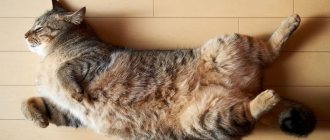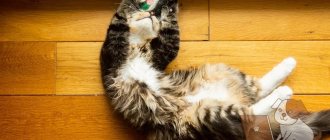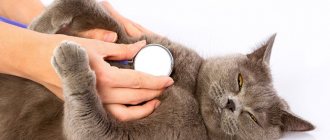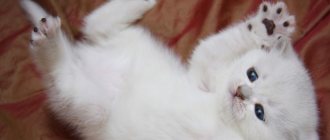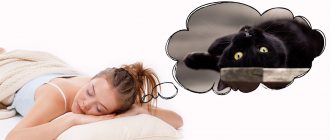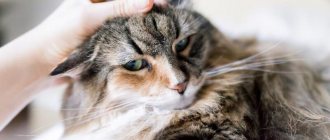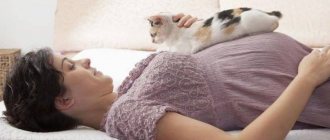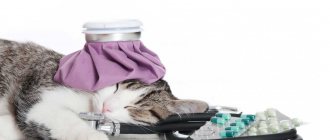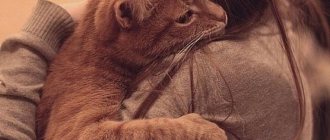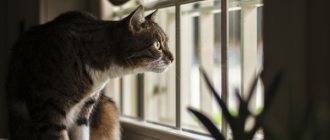All people had the opportunity to watch the cats while they dozed with their paws outstretched or tucked in. And furry predators sleep 12-18 hours a day, which is as much as two-thirds of their life! Considering that the position in which the pet lies with its belly up, legs outstretched, is considered an unprotected and vulnerable position, many owners were interested in the question - why does the cat lie on its back? Based on observations of felines, several interesting conclusions were made, which we will now introduce to you.
Why does the cat lie on its back?
Sleeping on your back: normal or pathological?
The instincts, behavior and habits of cats are in many ways similar to human ones. This applies not only to reactions and needs inherent in nature, but also to banal physical states: relaxation, tension, etc. During rest, a person can lie on his back, stomach, side, or in the fetal position. This is often due to the level of fatigue, mood, or a banal habit.
In their dreams, cats encounter different emotionally charged episodes.
Curious! Scientists conducted a number of experiments studying animals during sleep, in particular cats were experimental subjects. It turned out that they, like people, are no strangers to emotional dreams. Moreover, it was possible to decipher their contents. Mostly these are episodes of hunting, exploring the area, irritation and even fear.
They say that a cat sleeping on its back sees only good dreams.
Human and cat rest are similar in that during this time both are capable of experiencing happiness. For cats, one of the indicators of this condition is sleeping on their back. This body position is absolutely normal. There is no need to worry about the health of a kitten seen lying on its back with half-closed eyes.
Humpback and kyphosis: causes
In the case of a pathology called kyphosis, acquired and hereditary varieties are distinguished.
Congenital kyphosis occurs as a result of abnormal development of the anterior part of the vertebrae. In particular, congenital kyphosis can occur due to improper selection of a pair of parents. For example, in the Scottish breed it is allowed to cross only Folds with Straights (these are two varieties of Scottish cats): Scottish cats cannot be mated with other breeds. Mestizos sometimes have a curved back.
Genotypic kyphosis is inherited from parents. The “humpback gene” is dominant: if one of the parents has it, the kittens will also be humpbacked. Therefore, competent breeders exclude humpback cats and cats from breeding programs.
Compression kyphosis can result from a compression fracture of the spine. This curvature looks like an angle with the apex up (angular kyphosis).
Tuberculous kyphosis appears due to the destruction of the vertebral bodies and their compression. Tuberculous kyphosis is also angular.
Mobile kyphosis is the result of weak back muscles.
Rachitic kyphosis accompanies a disease such as hyperparathyroidism and usually appears before 5 months. Hyperparathyroidism, in turn, is caused by improper feeding, and also appears in kittens in the womb due to problems in the mother’s body.
Senile kyphosis is caused by age-related degenerative-dystrophic changes in the spine and/or weakening of muscles, which is typical for old animals.
To diagnose kyphosis and determine the type, the veterinarian first examines and palpates (palpates) the patient, then prescribes an x-ray and sometimes a myelogram (analysis of the contents of the bone marrow after taking a puncture).
A verdict is made only based on research. If the veterinarian did not do this and made a diagnosis only on the basis of an examination, you should contact another specialist.
Features of cat sleep
Every average nine-year-old cat slept for at least six years! However, “overslept” is a rough definition, more like dozed off. Cats allow themselves sound, healthy sleep much less often; they spend most of their lives in the relaxation stage.
Video - How and where cats prefer to sleep
Sleep phases
Table 1. Physiological changes in different stages of sleep
| Criterion | Slow phase | Fast phase |
| Heart | Reducing heart beats | Increased heart rate, pulse may be uneven |
| Lungs | Slowing down your breathing rate | Breathing rate is variable |
| Muscles | Muscle relaxation | Convulsive movements of the tail, paws, twitching of the ears |
| Eyes | Slow fading eye movements occur under the eyelids | Rapid eye movement |
| Body temperature | Decreases (to several degrees) | Increasing |
| Arterial pressure | Decreases | Increasing |
During half-sleep, pets do not cut off contact with the outside world, but continue to receive a continuous stream of information about what is happening around them. This feature is reflected in the position they choose to rest. If we take a closer look at the position of the entire body, we will notice that in most cases the animal takes a “on the alert” position. This means that if an irritant appears, the cat is ready to jump up sharply, and then either run away or attack.
Behind the cat's apparent relaxation, combat readiness is sometimes hidden.
Light, short sleep helps predators quickly regain strength for a short period of time to do intense work before the next period of slumber.
It is impossible to stay on constant “recharging”, so cats plunge into a healthy and sound sleep at a certain moment for the full restoration of the entire body, in particular the immune system. In this case, cats do not immediately wake up in full mobilization of strength.
A cat may unexpectedly end up on its back while sleeping
You can tell that the cat didn’t just close his eyes for five minutes, but fell asleep fully by his posture. It happens that a cat falls asleep in a half-curled position, but over time it begins to toss and turn and ends up on its back, with its paws tucked or spread out. Lying with his eyes closed in this position, the cat is not just dozing - he is completely relaxed and immersed in deep sleep, being completely indifferent to external stimuli.
Discharges and discharges in diseases in cats
Symptoms of some diseases include discharge from the eyes/nose/genitals.
Discharge is the release of purulent, catarrhal (mucous), catarrhal-purulent, hemorrhagic (with blood) exudate. Normally, cats can discharge only from the genitals and only in two cases - during estrus or during pregnancy. But such discharge should not be mixed with pus and should not have an unpleasant, putrid odor. The cat may have slight discharge from the prepuce (remnants of smegma or lubricant).
There should be no discharge and/or discharge from the eyes and nose, therefore, if any appear, this is a sign of the disease.
Why does a cat like to lie on its back?
It is no secret that to sleep, animals take the most unrealistic, sometimes hanging, poses and places that are not at all suitable for this matter: radiators, trees, flower pots, the owner’s face.
Table 2. Favorite cat sleeping positions
| Popular name | Body position | |
Incognito style | The pet curled up into a ball, hiding its hind legs and muzzle. Often the ears and tail are flattened | With this pose, cats intuitively protect their vulnerable areas: the throat and stomach. If your pet often curls up in its sleep, this does not mean that it is wary and does not trust anyone, it is just another effective way to keep warm. |
Fetal position | The pet will curl up, tucking one paw. The other three are in a free position | By examining a cat sleeping on its side, you can understand whether it is left-handed or right-handed. This depends on the tucked paw, since it is a pushing one. As a rule, for left-handers, the pushing paw is the right one, and vice versa |
Horizontal version | The pet is spread out at full length, lying on its side | This position is similar to the position of the body on its back, when the animal is as relaxed as possible and immersed in deep sleep. |
Emperor style | The pet lies on its back with its paws stretched up | The most attractive cat sleeping position due to maximum muscle relaxation |
Habit since childhood
The funny pose was imprinted in the memory of predators at that stage of their life when their eyes barely opened. It is known that small kittens spend about 65% of their time in REM sleep. During these few months after birth, they are carefully licked by their mother’s tongue while the kittens bask under her warm fur.
Sleeping on the back is common for both kittens and adults.
These moments of calm and bliss are presumably stored in the pet and manifest as rare (or frequent) episodes in the cat's adult life. Returning to the “roots” allows animals to feel like carefree and happy kittens again.
Confidence
Just like for dogs, for cats, exposing their belly is a sign of friendliness. If a domestic animal is sure that it is absolutely safe, feels protected in a familiar environment with people it knows, then it can allow itself to roll over on its back and even fall asleep like that.
A cat can only allow itself such a vulnerable pose when surrounded by its closest ones.
At the same time, everything can change if new people appear around the pet. A cat, sensing an unfamiliar smell, strives, at a minimum, to protect itself with a more modest pose, wake up, or even run away to another place.
Comfort
When cats bend in a bizarre way and sleep soundly, you should not find a hidden meaning in this, call the doctor or forecast the weather. Basically, for pets, this position simply seems convenient. You shouldn’t deliberately turn them over and make them “the best way.”
Cats do not make unnecessary movements - if they have chosen this position, then it is the most comfortable
Need for affection
It is not difficult to understand what the insidious cat wants when it begins to sway and stretch, touching observers with its flexibility and grace. The animal thus demonstrates its humility and offers to immediately, before it changes its mind, gently and efficiently scratch its belly. For outsiders, displays of such emotions are rare, although in many cases it depends on the animal’s personal attitude towards people.
Sometimes the cat's bizarre pose is addressed to the owner and is a call to play
Attention! In the matter of affection, you should remain careful, since the graceful poses of a cat cannot always be regarded as an invitation to touch the beautiful. The stomach is the weak spot of any animal. For invading a cat's personal space, the punishment may be a blow with a clawed paw or a bite, which is a manifestation of a natural protective instinct. This rule of “mood” applies to absolutely everyone, both our own people and strangers, regardless of whether the cat is tamed or not.
When showing affection, be prepared for the fact that your pet may quickly change his mood
If anyone is interested in why cats roll over on their backs and pull their hands with their hind legs, then the answer is simple: this is inherent in their subconscious by nature itself. Similar behavior can be observed in the wild relatives of domestic cats: they do this to their prey, finishing it off, trying to rip open its stomach. In the case of domesticated pets, these traces of the hunting heritage remain intact.
Heat
Often it is the stuffiness that “falls” kittens onto their backs, forcing them to spread their paws in different directions, because with an open belly the body cools down faster. It is difficult for a person to understand this type of behavior, because at first glance, all cats, with the exception of some breeds, are equally fluffy in all places.
It is customary that the standard indicators of a cat’s body temperature are higher than the human norm. Even during the molting period, the fluffy coat begins to fit more tightly to reduce the air space that traps heat.
Lying on its back, the cat tries to lower its body temperature by airing its undercoat
In the hot summer, cats move to the floor even from the soft, barely occupied master's bed, because on the floor it feels cool. But such measures are not enough for cooling. Heat exchange in the abdominal area occurs faster, since there is less hair there, so cats “ventilate” by turning over on their backs.
Puberty
Discomfort in the groin caused by the desire of an uncastrated cat serves as another answer to the question that interests us. This revealing position helps ease the male's discomfort due to arousal. A person can only wait until the “March” period ends, or find a partner for the pet to mate with.
Binge eating
Tailed lovers of food and sleep have a habit of manipulating people by begging for food. Everything is used, from charisma to undisguised arrogance. Such manipulations sometimes backfire on pets: uncontrollable cat greed and boundless human generosity lead to overeating of the animal.
For overweight cats prone to overeating, sleeping on their back is the only way to rest without squeezing their stomach.
Having had enough, the pet craves only rest. And then he is faced with a problem: curling up into a ball or lying on his paws is painful and uncomfortable. Depending on the degree of overeating, he has to fall on his side or back so that nothing is squeezing his stomach.
Whenever possible, limit your pets from unauthorized access to food.
No matter how funny it may look, the gastronomic issue is not to be joked about. The owner, one way or another, takes responsibility for the one he has fed and tamed, so he must wisely calculate the proportions, making the cat’s diet balanced. If you are having difficulty weaning your pet from trying to eat the owner's food, below are some recommendations for pacifying the gourmet.
We stop the cat from begging for food
Other ailments
For a loving owner, his guests and just random passers-by, a cat resting on its back is a touching sight, a reason to take out a camera for a souvenir photo or to cuddle the animal until it recovers from sleep. Moving on to the planned actions, few people suspect about the health problems of the pet, due to which he selects this particular position.
In addition to behavioral characteristics, various diseases can also be the cause of sleeping on your back.
If sleeping on your back is a sign of illness, it will be accompanied by some of the following signals:
- the pet becomes restless;
- cannot find a place for himself;
- meows often and loudly;
- eats less often;
- cannot go to the toilet or does it too often.
If the cat behaves aggressively during palpation, then it is necessary to identify the source of pain
In this case, a visit to the veterinarian will not be unnecessary. Most likely, your pet may have:
- Digestive tract problems;
- Disease of the genitourinary system;
- Ailments in the groin and other inflammations.
Often, a sick animal does not allow itself to be touched, and when palpation is attempted, even the kindest domestic animal unexpectedly responds with aggression. You can find out more about cat diseases on our portal.
The cause of diseases associated with the inability to lie on the stomach is most often disturbances in the gastrointestinal tract.
If the cat’s tests indicate the absence of pathologies, then the reason for sleeping on the back is one or even several of the above points.
Sometimes, sleeping with their belly up, animals sniffle and even quite literally snore. This is not a symptom of pulmonary or heart failure unless the pet suffers from shortness of breath, poor appetite and inactivity when awake. Otherwise, housewives have nothing to worry about: the nasal septum in an uncomfortable position is slightly depressed, as happens in a person during snoring.
Diagnosis of the disease
If a cat's hind legs have failed, the first step to helping your pet is to consult a veterinarian. In most cases, the specialist prescribes a series of tests. Based on their results, it will already be possible to draw the first conclusions about the causes of failures of the musculoskeletal system.
Below we will consider the main directions of possible diagnoses for a pet, when and why it pulls its hind legs
| Violation | Description | Methods of influence |
| Purulent endomedritis in cats | Other manifestations of the disease are the pet’s thirst and frequent urination. A weakened state, in rare cases, a swollen abdomen and atypical behavior of the cat, manifested in frequent meows and pain | This type of disease can only occur in cats. As a treatment, it is recommended to undergo surgery to remove the inflamed ovaries and uterus. To avoid relapses, drug treatment is not recommended. |
| Pinched sciatic nerve | Has no obvious symptoms. There is a manifestation of some restrictions in movements, where the animal almost constantly pulls its paws. The cat often lies with its hind legs stretched out and generally has a sickly appearance. | The treatment takes place under the strict supervision of an experienced doctor. Since often in this state cats become more fearful and refuse outside interventions. |
| Disruption of internal organs | Problems with the liver and kidneys (urolithiasis, kidney failure) | It is necessary to take an x-ray of the spine, donate blood and urine. |
| Changes in the body by age in cats | Loss of appetite, sleep disturbances and other age-related manifestations in cats | Seeing a doctor to relieve symptoms of illness |
Does sleeping position depend on the breed?
This is not to say that there are unique breeds that have a special attitude towards sleeping on their back. Having excellent health and getting enough pleasure from life, both the Sphinxes and the British behave the same in this regard.
Don Sphynx curled up into a ball
The only thing that influences a cat’s choice of resting position is the density and density of the fur. Under favorable conditions, cats with different coats may feel differently. The one with sparse and small fur will most likely fall on his paws or curl up in a ball, but a cat with longer and thicker hair will fall asleep on his side or roll over on his back.
Associated symptoms
Let's look at the main signs of pain near the tail:
Fracture - in this case, the position of the tail will be lowered, and any impact on your part when trying to raise it will cause pain to the animal. Wound (violation of the integrity of the coat) - scratches and abrasions can be obtained during a fight with other cats or due to the carelessness and carelessness of the animal. Hair loss can also be the reason why a cat won't allow the base of its tail to be touched due to pain. A fungal growth or infection causes these symptoms. Fear - if the cat is afraid of something or has been beaten and humiliated repeatedly, the tail will be feathered and the base will hurt
Therefore, every touch to the animal will be accompanied by loud screams and plaintive meows. Allergies can occur both to food and household items (cleaning products, perfumes). Worms - development in the body will lead to pain in various parts of the body, including at the base of the tail.
It is sometimes almost impossible to determine the diagnosis on your own; even an experienced veterinarian in such cases, without appropriate diagnostic measures, will not be able to determine the disease by eye, so you should not delay going to him.
General thematic information
A typical sleeping position for mustachios is curled up with their muzzle buried in their paws. The scientific name for this position is incognito style: the owner sees only the fluffy ball. Also, the animal often lies on its back without showing concern - this is the second favorite position among furry cats. The following are the most common reasons explaining why a cat took a position lying on its back.
Coziness and convenience
The explanation is simple - the cat is comfortable: he is as relaxed as possible and rests, snoring sweetly. Some furries can even snore. In this case, there are no signs of anxiety, the animal does not twitch in its sleep.
If the room is warm, quiet, there are no screams or scandals, the atmosphere will also be cozy and pleasant, and a friendly environment also affects mustaches. The cat understands that he can completely relax and enjoy sleep, and takes the most intricate poses. Also, if the fluffy often lies on his back, this also indicates that there is positive energy in the home.
Love and understanding
Usatik loves his owner very much, trusting him with the most valuable things - himself and the protection of his sleep. Animals sleep soundly, lying on their backs and exposing their tummy, when they feel completely safe. The stomach for cats is the most vulnerable place: real “dared souls” leave it without cover in their sleep. Therefore, the “paws up” pose is a sign of boundless trust (especially if the fluffy sleeps next to the owner). The cat needs to be encouraged in return: to play, pamper him with goodies, and take care of his health.
Weather changes
Cats are excellent meteorologists; by their behavior you can notice upcoming weather changes. These animals are highly sensitive and react sharply to the slightest changes in the environment. Any change in the weather will immediately affect the normal behavior and habits of your pet. So, a pose on your back with your tummy up can symbolize the coming warming. Cats lie like this even when the heat comes soon.
What foods from the human table are dangerous for dogs How do dogs sense our illnesses? 6 Effective Ways to Stop Your Dog from Chewing Things Are Dogs Really Shouldn't Eat These Foods?
It's time for physiological changes
Puberty or attraction causes mustachioed boys to roll over onto their backs and sleep this way, with their hind legs spread wide. At this time, the animal experiences physical discomfort, and in this position, tension and excitement are significantly reduced. Therefore, if the cat is not neutered, it’s time to think about carrying out this procedure.
REFERENCE! It is more convenient for pregnant cats to sleep on their backs when they are expecting a rich litter. There will be many kittens or they will be large.
The cat is a glutton
After overeating and filling its belly, the cat looks for the most comfortable position for sleep and relaxation. The portion he has just eaten prevents him from lying on his stomach: the usual positions for a mustache are uncomfortable and even painful. Therefore, lying on your back becomes most comfortable - a full belly does not compress anything, and the heaviness is not felt so much.
This is interesting: How to give Lincomycin to a cat?
The basic Instinct
Under the influence of sex hormones, a cat’s behavior changes dramatically, triggering a chain of complex psychophysiological reactions associated with finding a partner, mating, bearing offspring, giving birth and caring for babies:
- Sexual hunting. The period of sexual activity in females is called “estrus” (translated from Greek as “passion, frenzy”), and in the cat family it is expressed unusually brightly and intensely. Wild cats, usually leading a solitary lifestyle, demonstrate their readiness to mate very clearly, literally seducing the male. In a pride, a lion secludes himself with a lioness in heat and mates with her every 20-30 minutes. Domestic cats repeat the ritual of their wild ancestors in mating games, sometimes “walking” so violently and loudly that they haunt the whole family for several days. An inviting loud meow, arching of the back in an eloquent stance on half-bent legs with a raised tail are replaced by turning over on the back and uterine purring. This is how a cat calls a cat. Cats can lie belly up and roll on the floor from excess feelings immediately after mating. Cattery owners know that such behavior is one of the clear signs of a successful cat “wedding,” which can take place far from human eyes.
- "Interesting situation." A pregnant cat may roll on its back, making vibrating sounds in its throat. Even when signs of pregnancy are still invisible to the owner, altered hormonal levels dictate different behavior patterns for the animal. First-born cats who do not yet have experience in bearing offspring are especially prone to “gymnastics for pregnant women.” The expectant mother feels the birth of a new life inside her and is undoubtedly excited. In the second half of pregnancy, when the kittens are already actively moving and stretching their legs, she can growl at the naughty kids in her stomach, growl loudly or lick them through her side.
- Mother-nurse. The mother cat lies on her back to provide her newborn kittens with access to her nipples. If the birth went well and the whole family is happy, the nurse sleeps blissfully, warming the precious babies.
Reasons for concern
Lying on your back can also serve as a signal about the development of certain pathologies. These can be diseases of the intestines, kidneys, inflammatory processes in the body. The cat falls on its back, while it does not allow its owners to approach it, does not allow it to be touched (attempts to palpate the stomach will cause attacks of aggression in the animal). There are also additional symptoms:
- lack of appetite;
- stool disorders;
- constant meowing;
- general lethargy or restless behavior.
If such signs are present, urgent consultation with a veterinarian is necessary. A series of tests and treatment may be required.
So, if your pet furry loves to lie on his back and there are no suspicious symptoms, there is no reason to worry. With this pose the animal shows its trust and happiness. Lying on your back is also comfortable in hot weather or after a heavy meal. But you should be wary if the cat is lying on its back, but at the same time lethargic, painful, and apathetic. In such a situation, immediately visit the veterinarian.
Trust in the owner
A pose on his back with his paws up is a sign that the fluffy completely trusts the situation and the person. This is only possible when a warm relationship is established between the owner and the animal. The cat sees protection in a person and trusts him to guard his sleep. Also, at the same time, fluffies can bend and hang from surfaces - this is how they express complete happiness and contentment with life.
REFERENCE! An indicator of special trust: the cat lies down on the floor, turns over on its back and begins to “stretch” in front of the owner.
Take care of your belly
The throat and belly are vital parts of the body, and exposing them leaves the animal vulnerable. With decreased vigilance and muscle relaxation, the threat increases, so in the wild, solitary felines are always on the alert.
Their sleep mainly consists of a light doze in a compact position on tucked up paws or, bending over, on their side. From this position you can instantly jump up, like an elastic compressed spring, in order to repel the enemy in time or escape.
Memory from childhood
The mother licks the fur of small kittens with her tongue, and pays special attention to the tummy. This serves as both a necessary hygienic procedure and a measure to prevent digestive problems in the baby. After such a massage, the kitten feels good, he is calm and completely relaxed, and quickly falls asleep. A grown pet retains this picture from childhood in its memory, and sleeping on its back gives it complete peace of mind.
When to worry
Dandruff in a cat: on the back, at the tail, causes and treatment
Sometimes sleeping on its back causes the animal to spread its legs wide. Sometimes this is a sign of a serious pathology. A visit to the veterinarian and diagnostic testing are recommended for pets with the following symptoms:
- unreasonable anxiety, increased irritability;
- searching for secluded places or demonstratively drawing attention to one’s own person;
- frequent and loud meowing in an unusual tone;
- refusal to eat or independently reducing portions to minimum sizes;
- frequent trips to the toilet to empty the bowels or bladder;
- prolonged absence of urination or bowel movements;
- elevated temperatures.
Frequent trips to the toilet are the first sign that something is wrong with the animal.
Apathy and indifference to external stimuli are dangerous signs that indicate the active activity of pathogenic microflora in the body of cats. In some cases, the problem is associated with helminths and intoxication of the body from their waste products.
A rabbit is licking your hand diligently, what does this mean?
He stretched out his neck and stood on his hind legs, which means he is showing curiosity. He is interested in something, he tries to look better, or reaches for the outstretched treat
Pushing with his muzzle means he is trying to attract your attention. Pet the rabbit and give him a treat
He looks fearfully, his ears are pressed back - he’s scared of something. In this case, you need to step away and give time to calm down. Then feed and pet him so that he feels safe in your presence.
A calm, friendly rabbit sits while being petted. If you stop petting, he will demand their continuation or run away. A rabbit licks and bites your hand - it means he is deeply attached to you. Usually the rabbit really likes to be stroked on the head. You can scratch his forehead against the grain, as well as the back corner of his jaws (but not the bottom!), the base of his ears, while lightly and very gently pulling the ears.
In fact, rabbits behave very similar to animals such as cats. So if for some reason you don’t want to take a rabbit as a pet, but want warmth and care, you can take a cat into good hands, after all, a cat is a more familiar animal, and it’s easier to care for it.
Rabbits love to have the inner corners of their eyes rubbed. To show affection, they may lick your clothes or any of your objects. The rabbit may grind its teeth slightly with pleasure. This sound is sometimes called “tooth purring.” Some rabbits, showing how pleasant they are, “mumble.” They can even be aggressive when seeking affection. This bad habit should be eradicated.
If a rabbit pushes you hard with its nose, it means it wants you to let it through. There are several positions that a rabbit will take depending on how comfortable it feels. If he lies on his stomach and has picked up his paws, muzzle
Source
